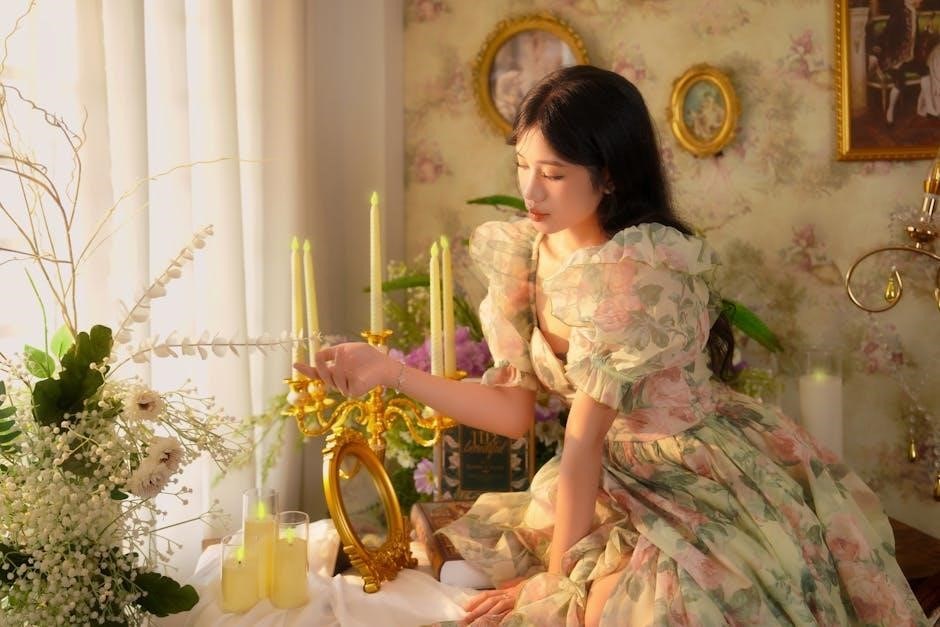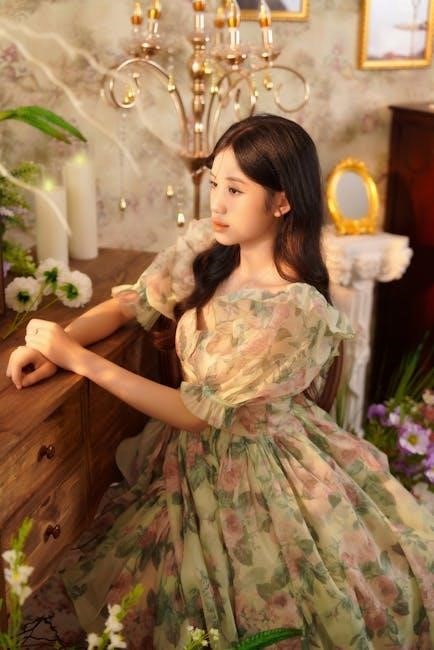The story explores themes of justice, love, and sacrifice, while the PDF version provides convenient access for deeper analysis and understanding of its moral dilemmas.
1.1 Overview of the Story
“The Lady, or the Tiger?” by Frank R. Stockton is a captivating tale set in a semi-barbaric kingdom. The story revolves around a unique justice system where accused individuals choose between two doors, one leading to death by a tiger and the other to marriage with a beautiful lady; The plot follows a lover’s dilemma when his princess lover discovers what lies behind each door. The story ends ambiguously, leaving readers to ponder whether the lady or the tiger emerged. The PDF version offers a convenient way to explore this moral and philosophical puzzle.
1.2 Historical Context and Background
Written by Frank R. Stockton in 1884, “The Lady, or the Tiger?” reflects the Victorian era’s fascination with exotic justice systems and moral dilemmas. The story is set in a semi-barbaric kingdom, blending elements of romance and philosophy. Its unique premise of a trial by choice between a lady and a tiger captivated readers, sparking debates about justice, love, and sacrifice. The historical context highlights the era’s exploration of complex human emotions and societal norms. The PDF version of the story preserves its original charm, making it accessible for modern readers to analyze and reflect on its timeless themes.
1.3 Importance of the PDF Version
The PDF version of “The Lady, or the Tiger?” offers a convenient and accessible format for readers to engage with the story. It provides a portable and easily shareable document, ideal for educational purposes. The PDF preserves the original text’s integrity while allowing for annotations and highlights, enhancing study and analysis. Additionally, it often includes supplementary materials like discussion questions, teaching guides, and literary device analysis, making it a valuable resource for both students and educators seeking to deepen their understanding of the story’s themes and moral dilemmas.

Plot Summary
The story revolves around a king’s unique justice system, where a lover faces a life-or-death choice between a lady or a tiger in an arena trial, highlighting moral dilemmas.
2.1 The King’s Unique Justice System
The king’s justice system is both barbaric and intriguing. Criminals face a public trial in an arena with two doors: one leading to a ferocious tiger, symbolizing death, and the other to a lady, representing life and marriage. The choice is left to fate, but the princess discovers the secret behind the doors, creating a moral dilemma for her lover. This system reflects the king’s desire for justice through chance, blending brutality with romantic idealism, making it a central element of the story’s tension and philosophical debate.

2.2 The Trial in the Arena
The trial in the arena is a dramatic and tense spectacle. Two doors are presented: one conceals a ferocious tiger, symbolizing death, while the other hides a beautiful lady, representing life and marriage. The accused must choose a door, and the crowd eagerly awaits the outcome. The public’s emotions are heightened, as they cheer for the lady and recoil at the tiger. This brutal yet captivating method of justice creates a moral and emotional dilemma, especially when the princess’s lover is the one on trial, forcing her to make a heartbreaking decision.
2.3 The Princess’s Role in the Story
The princess plays a central role, as her lover’s fate rests in her hands. She cleverly discovers what lies behind each door, showcasing her wit and determination. Torn between her love and jealousy, she faces an agonizing decision. Her choice drives the story’s climax, highlighting her emotional depth and the moral complexity of the situation. The princess’s actions ultimately define the story’s unresolved ending, leaving readers to ponder her final decision.
2.4 The Lover’s Dilemma
The lover faces an impossible choice between survival and justice. If he opens one door, he meets the lady and potential marriage; the other releases a tiger, ending his life. The princess’s guidance complicates his decision, as her motives blur between love and jealousy. His dilemma symbolizes the conflict between desire and fate, leaving readers questioning his ultimate choice and the story’s hauntingly ambiguous conclusion.
Author and Background
Frank R. Stockton, a renowned American writer, crafted this tale of moral complexity. His unique storytelling style captivated readers, blending suspense with philosophical inquiry into human nature and justice.

3.1 Frank R. Stockton: The Author
Frank R. Stockton was a celebrated American writer known for his imaginative and thought-provoking stories. Born in 1834, he gained fame for works like “The Lady, or the Tiger?” which remains his most enduring tale. Stockton’s writing often explored moral dilemmas and human nature, blending humor with philosophical depth. His unique style captivated readers, making him a significant figure in 19th-century American literature. The PDF version of his works continues to be widely studied, offering insights into his literary genius and timeless themes.
3.2 His Writing Style and Themes
Frank R. Stockton’s writing style was imaginative and engaging, often blending humor with moral ambiguity. His works explored themes of justice, love, and human nature, as seen in “The Lady, or the Tiger?” Stockton’s stories frequently presented ethical dilemmas, challenging readers to reflect on complex choices. His use of ambiguous endings, leaving key decisions unresolved, became a hallmark of his storytelling. This approach fostered deep discussion and analysis, making his tales memorable and thought-provoking. The PDF version of his stories preserves this style, offering readers a timeless literary experience.
3.3 The Time Period of the Story
The story of “The Lady, or the Tiger?” is set in a semi-barbaric kingdom, suggesting a medieval or ancient time period. The king’s justice system, involving trials in an arena with a lady or a tiger, reflects a primitive yet dramatic societal structure. While the exact time period is not specified, the narrative’s focus on royal decrees and moral dilemmas evokes a sense of antiquity. The PDF version of the story preserves this timeless setting, allowing readers to immerse themselves in its unique and captivating world.
Themes and Symbolism
Explores themes of justice, love, and sacrifice, creating a moral dilemma.
The lady symbolizes love and choice, while the tiger represents death and consequence.
4;1 The Theme of Justice
The story critiques a unique justice system where the accused chooses between two doors, one revealing a lady for marriage, the other a tiger for death. This public spectacle raises questions about fairness and morality, highlighting the brutality of using chance to determine guilt; The king’s method, while entertaining for the crowd, undermines true justice, emphasizing spectacle over fairness. The tale challenges readers to reflect on the nature of justice and its implementation, blending drama with philosophical inquiry into right and wrong.
4.2 The Theme of Love and Sacrifice
The story delves into the profound themes of love and sacrifice, as the princess risks everything to save her lover. Her actions highlight the depth of devotion and the moral dilemmas faced when personal feelings clash with societal expectations. The tale leaves the outcome ambiguous, prompting readers to ponder whether love triumphs or sacrifice prevails, adding a layer of emotional complexity to the narrative.
4.3 The Symbolism of the Lady and the Tiger
The lady symbolizes love, purity, and hope, while the tiger embodies punishment, passion, and primal instincts. The contrast between the two reflects the story’s central dilemma, forcing the lover to choose between survival and betrayal. The lady represents the civilized aspect of human nature, while the tiger signifies the savage consequences of justice. This symbolism highlights the tension between reason and emotion, leaving readers to ponder the moral and ethical implications of the lover’s choice.
Study Resources and PDF Availability

The PDF version of “The Lady, or the Tiger?” is widely available online, offering study resources like discussion questions, answer keys, and literary analysis to aid comprehension.
5.1 Discussion Questions and Answers
Discussion questions and answers for “The Lady, or the Tiger?” are available in the PDF version, helping students analyze the story’s moral dilemmas and themes. These resources include queries about the king’s justice system, the princess’s motivations, and the symbolic meaning of the lady and the tiger. Additionally, answers provide insights into the story’s ambiguous ending, encouraging critical thinking and debate. The PDF also offers teaching guides, making it a valuable tool for both students and educators seeking to explore the story’s depth and complexity.
5.2 Teaching Guides and Lesson Plans
Teaching guides and lesson plans for “The Lady, or the Tiger?” are readily available in the PDF version, offering educators structured approaches to explore the story. These resources include activities, discussion prompts, and exercises designed to engage students and deepen their understanding of the narrative. Lesson plans often focus on themes like justice, love, and sacrifice, while also analyzing literary devices and moral dilemmas. The guides provide flexibility, catering to various teaching styles and student needs, making the story an engaging and thought-provoking experience for the classroom.
5.4 Analysis of Literary Devices
The PDF version of “The Lady, or the Tiger?” offers detailed analyses of Stockton’s literary devices, including symbolism, suspense, and irony. The lady and tiger symbolize love and death, while the arena represents a moral battlefield. The story’s ending, left unresolved, employs dramatic irony, challenging readers to ponder justice, love, and sacrifice. These devices enhance the narrative’s depth, making it a rich text for critical exploration and classroom discussion. The PDF provides insights into how these elements contribute to the story’s enduring appeal and thematic complexity.

Adaptations and Sequels
The story inspired a sequel resolving its mystery and various film and stage adaptations, exploring its themes in different mediums, as detailed in the PDF version for analysis;
6.1 Film and Stage Adaptations
The story has been adapted into various films and stage plays, including a notable 1944 film and stage productions that bring the moral dilemma to life. The PDF version highlights these adaptations, offering insights into how the story’s themes of justice and love have been interpreted across different mediums. These adaptations provide a fresh perspective on the timeless tale, allowing audiences to engage with the narrative in new and compelling ways, as detailed in the PDF resources available for study and analysis.
6.2 The Sequel: The Lady, or the Tiger? Part II
A sequel to the original story, The Lady, or the Tiger? Part II, was written years later, aiming to resolve the infamous cliffhanger. The PDF version discusses this continuation, exploring the resolution of the lover’s fate and the princess’s decision. It delves into the moral and emotional consequences of the trial, providing closure while maintaining the story’s philosophical depth. This sequel adds a new layer to the tale, satisfying readers’ curiosity and expanding the narrative’s complexity, as detailed in the PDF resources available for further study.
The story’s moral dilemmas and themes of justice and love remain timeless, with the PDF version offering a convenient resource for deeper exploration and analysis of its complexities.
7.1 Final Thoughts on the Story
The Lady, or the Tiger? leaves readers with a haunting moral dilemma, blending justice, love, and sacrifice. Its open-ended conclusion sparks endless debate, reflecting human nature’s complexity. The story challenges readers to weigh passion against duty, making it a timeless exploration of human emotions. The PDF version ensures accessibility, allowing modern audiences to engage with its enduring themes and philosophical questions. Stockton’s masterpiece remains a powerful tale, inviting reflection on justice, love, and the unpredictability of human choices.
7.2 The Relevance of the PDF Version

The PDF version of The Lady, or the Tiger? offers unparalleled accessibility and convenience. It allows readers to engage with the story anytime, anywhere, making it ideal for educational purposes. The digital format often includes annotations, study guides, and discussion questions, enhancing comprehension. For students and educators, the PDF serves as a vital resource for analyzing themes and literary devices. Its availability ensures the story’s enduring relevance, enabling new generations to explore its moral dilemmas and philosophical depth with ease.

FAQ
Q: What is the main conflict in “The Lady, or the Tiger?”
A: The story revolves around a lover’s choice between a lady or a tiger, symbolizing justice, love, and sacrifice.
Q: Is the PDF version helpful for students?
A: Yes, it provides study guides, discussion questions, and analyses for better understanding.
Q: Does the story have a clear ending?
A: No, the ending is ambiguous, leaving the outcome to the reader’s interpretation.
Q: Why is the story relevant today?
A: It explores timeless themes like justice, morality, and love, making it a classic for modern readers.
8.1 Frequently Asked Questions
Q: What is the central theme of “The Lady, or the Tiger?”
A: The story explores justice, love, and sacrifice, leaving readers to ponder moral dilemmas.
Q: Is the PDF version of the story available for free?
A: Yes, the PDF can be downloaded from various educational platforms like CommonLit for study purposes.
Q: Why is the ending ambiguous?
A: The ending is left open to encourage readers to reflect on the moral and emotional implications.
Q: How does the princess know what is behind the doors?
A: The princess discovers the truth through her own investigation and loyalty to her lover.
Q: Is the story suitable for students?
A: Absolutely, it sparks critical thinking and discussion about justice, love, and human nature.
8.2 Common Misconceptions

Some readers believe the story provides a clear ending, but it famously leaves the outcome unresolved.
Others assume the princess’s decision is entirely selfless, yet her motivations may stem from jealousy.
A common myth is that the king’s justice system is entirely fair, when in fact, it is deeply flawed.
Additionally, many think the PDF version is difficult to find, but it is widely available online for free.
Finally, some believe the story is only for academic use, while it also appeals to general readers for its timeless themes.
